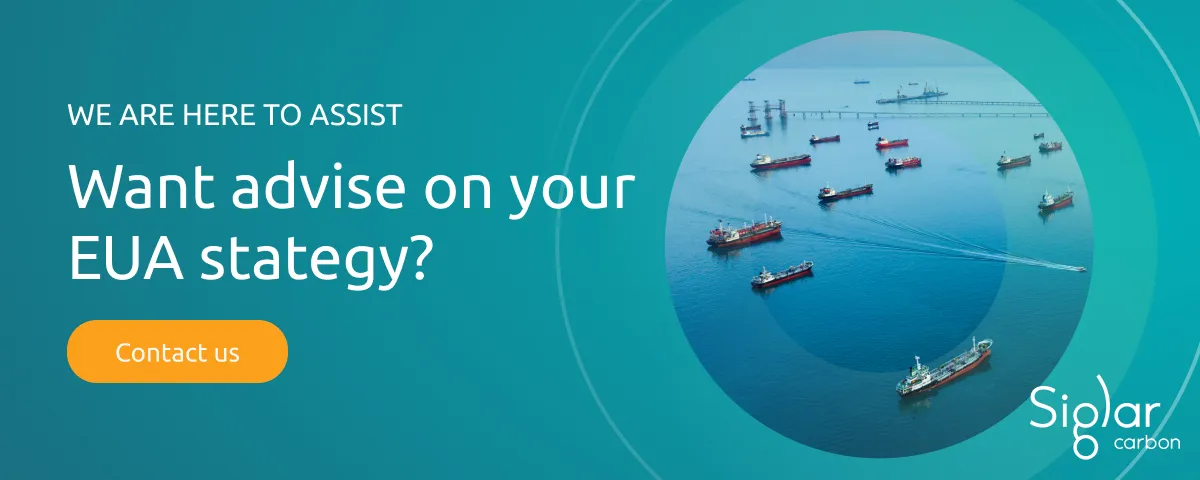Lorem ipsum dolor sit amet, consectetur adipiscing elit. Suspendisse varius enim in eros elementum tristique. Duis cursus, mi quis viverra ornare, eros dolor interdum nulla, ut commodo diam libero vitae erat. Aenean faucibus nibh et justo cursus id rutrum lorem imperdiet. Nunc ut sem vitae risus tristique posuere.
A common misconception among charterers and shipowners is that they don't need to worry about the EU Emissions Trading System (ETS) until September 2025. However, if you're signing charter parties in 2024, this mindset could be akin to signing a blank cheque.
The confusion often arises because EU allowances (EUAs) are due to be surrendered in September2025. Yet, the emissions from today's voyages will determine the number of allowances required, and the fluctuating EUA price will affect the cost. Therefore, creating an EUA strategy now is crucial to avoid future surprises.
As a charterer, consider these three essential questions when developing your EUA strategy:
Your EUA risk profile should guide whether to pay your share in EUAs or in cash and when to settle the cost. Paying in cash at the time of signing the charter party involves minimal risk but limited opportunities. Settling with allowances in autumn 2025 allows for trading opportunities in the time span between the charter party settlement and the surrendering of allowances.'
Voyage emissions will determine the number of EUAs required. As your chartering decisions can significantly impact these emissions, granular and predictive emissions data is vital.
Access to insights at voyage leg level will, for example, help clarify where your responsibility starts and ends. As a long ballast leg can be a major emissions driver, knowing where the ship is ballasting from is important. For instance:
The EUA spot market is volatile and knowing the price forecast is essential. Looking back 12 months we see a high low spread in the EU allowance price of more than 40 euros. For our examples, this spread would translate to a difference in voyage EUA cost of approximately 110 000 euros for the VLCC voyage and 14 000 euros for the MR voyage.
In conclusion, understanding and managing your emissions data is crucial for navigating the complexities of carbon costs and regulations. A well-defined EUA strategy will help you mitigate risks and capitalise on opportunities, ensuring you're prepared for future regulatory requirements. Don't wait until it's too late—start planning now to secure your financial future in an evolving regulatory landscape.

The confusion often arises because EU allowances (EUAs) are due to be surrendered in September2025. Yet, the emissions from today's voyages will determine the number of allowances required, and the fluctuating EUA price will affect the cost. Therefore, creating an EUA strategy now is crucial to avoid future surprises.
As a charterer, consider these three essential questions when developing your EUA strategy:
Your EUA risk profile should guide whether to pay your share in EUAs or in cash and when to settle the cost. Paying in cash at the time of signing the charter party involves minimal risk but limited opportunities. Settling with allowances in autumn 2025 allows for trading opportunities in the time span between the charter party settlement and the surrendering of allowances.'
Voyage emissions will determine the number of EUAs required. As your chartering decisions can significantly impact these emissions, granular and predictive emissions data is vital.
Access to insights at voyage leg level will, for example, help clarify where your responsibility starts and ends. As a long ballast leg can be a major emissions driver, knowing where the ship is ballasting from is important. For instance:
The EUA spot market is volatile and knowing the price forecast is essential. Looking back 12 months we see a high low spread in the EU allowance price of more than 40 euros. For our examples, this spread would translate to a difference in voyage EUA cost of approximately 110 000 euros for the VLCC voyage and 14 000 euros for the MR voyage.
In conclusion, understanding and managing your emissions data is crucial for navigating the complexities of carbon costs and regulations. A well-defined EUA strategy will help you mitigate risks and capitalise on opportunities, ensuring you're prepared for future regulatory requirements. Don't wait until it's too late—start planning now to secure your financial future in an evolving regulatory landscape.
